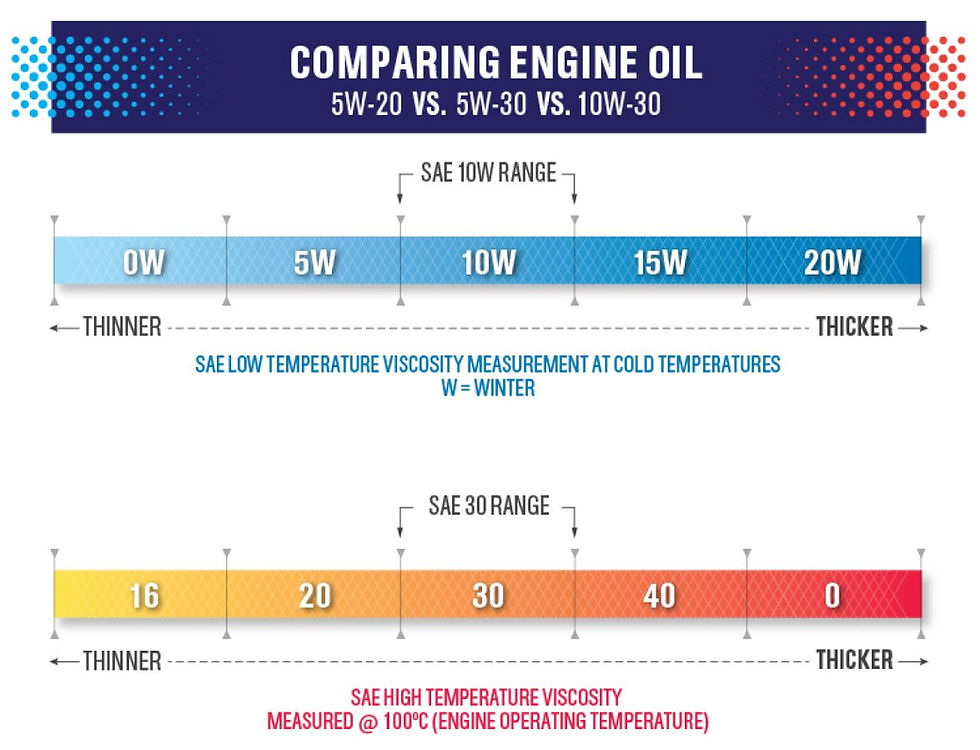UNDERSTANDING ENGINE OIL VISCOSITY
- Castrol
- Sep 7, 2021
- 3 min read
The word viscosity describes how easily an engine oil flows. Here we explain what descriptions like 0W-20 and 5W-40 actually mean.

WHAT DO OIL VISCOSITY NUMBERS MEAN?
Viscosity is the resistance to flow of a fluid. Motor oil viscosity grades are based on a scale developed by the API (American Petroleum Institute) lubricant organization. The values are defined in a specification known as API 1509 and are based on the resistance the oil gives to flowing at two different temperatures – cold and high temperature. The measurement of viscosity at high and low temperatures are properties of multi-grade oils. Years ago, most vehicles used one viscosity grade oil in the summer and a different viscosity grade oil in the winter. But as motor oil technology advanced, additives such as viscosity index improvers allowed for the use of the same grade of oil year-round.
The low temperature viscosity of the oil is a measurement that simulates starting a car on a cold winter day. That value has the letter “W” after the number and has a dash after the W. For example, if the oil is a 5W-30, the 5W part describes the viscosity of the oil at low temperatures. The lower the number, the faster the oil will flow at vehicle start up.
The high temperature viscosity is the number after the dash and is related to the viscosity of the oil as it is moving around your engine after the car has warmed up and is at normal engine temperature. In the 5W-30 example, the 30 defines the viscosity of the oil at normal engine temperatures. Again, the lower the number, the lower the viscosity of the oil and the faster the oil will move around the engine.
As an example, let’s compare 5W-20, 5W-30 and 10W-30 motor oils. A 5W-20 and 5W-30 will have very similar if not equal viscosity at lower start-up temperatures. But as the engine heats up, the 5W-20 will move with less resistance than an 5W-30. Less resistance results in improved fuel economy but the oil is not as thick and forms a smaller layer of protection between metal surfaces. If we compare a 5W-30 and a 10W-30, they will behave very similarly as the engine heats up, but at start-up, the 5W-30 will provide less resistance and start easier than the 10W-30. The 5W-20 will have a lower viscosity and provide less resistance than the 10W-30 at both start-up and normal engine operating temperatures.
In the past, it was common for vehicles to require higher viscosity oils such as 20W-50’s, 10W-40’s and 10W-30’s. But as engine technology has advanced over the years, the size of engines and pathways in engine that oil flows through have gotten smaller and thinner. This has led over time to motor oil viscosity decreasing – currently 5W-30 and 5W-20 are the most popular grade and 0W-20 is the fastest growing grade. These lower viscosity motor oils are needed to move through the thin engine pathways to protect and clean metal surfaces. Lower viscosity motor oils also result in better fuel economy.
WHAT OIL VISCOSITY SHOULD YOU USE?
As far as the best oil to use, the best place to find that information out is in your vehicle owner’s manual. In the owner’s manual, there are very often sections on maintenance and lubrication. It is here where the company that made your vehicle will describe the correct oil for your vehicle. Another great source to find the correct oil for your vehicle is the Castrol Oil Selector, or by contacting our technical experts at Bosveld Smeermiddels.
Newer vehicles are more often going to lower viscosity oils to protect their advanced technology engines. Some auto manufacturers will also call for certain specifications that they have developed for their engines. Always check the motor oil container for the specifications that the motor oil meets – it will likely be found on the back label of the oil container.

(Originally published on Castrol US https://www.castrol.com/en_us/united-states/home/motor-oil-and-fluids/engine-oils/oil-viscosity-explained.html)

Kommentare